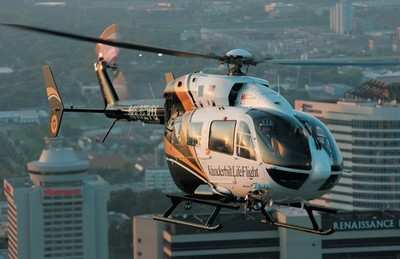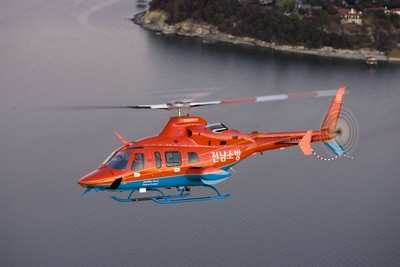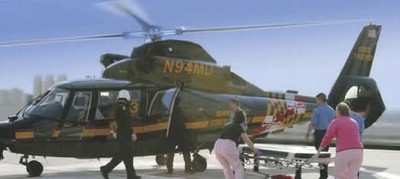 A missive from the
Association of Air Medical Services (AAMS) notes that the medical
helicopter industry has come under great public scrutiny recently -
particularly regarding safety and appropriate usage concerns - but
also in relation to questions over foreign-travel access and
evacuation-insurance coverage, which have been prompted by the
tragic death of award-winning actress Natasha Richardson from a
traumatic brain injury after a fall on a Canadian ski slope.
A missive from the
Association of Air Medical Services (AAMS) notes that the medical
helicopter industry has come under great public scrutiny recently -
particularly regarding safety and appropriate usage concerns - but
also in relation to questions over foreign-travel access and
evacuation-insurance coverage, which have been prompted by the
tragic death of award-winning actress Natasha Richardson from a
traumatic brain injury after a fall on a Canadian ski slope.
To help the public better understand the issues, AAMS is
conducting a public education campaign regarding the importance of
air medical transport in our nation, particularly in rural and
other underserved areas.
"Most people don't realize the life-and-death role that
emergency medical helicopters play in our healthcare system," said
Sandy Kinkade, president of AAMS. "But the critically ill and
injured are airlifted once every 90 seconds in our nation. That's
why it's important to have medevac services in places where they
are needed - because the life saved might be yours or a loved
one's."

Kinkade would like to remind the American public of the
following facts related to air-medical services:
- Medevac helicopters provide both a higher level of medical care
(than is typically found on a ground ambulance), as well as a
speedier response. The crews on medical helicopters are highly
sophisticated, with physician-level capabilities. A typical crew
consists of a specially-trained critical care nurse and a paramedic
but can also include other specialists (such as a neonatologist or
respiratory therapist) as necessitated, depending on the patient's
condition.
- Almost exclusively, these crews handle the most critically ill
and injured patients, thus giving them more experience in dealing
with severe cases than typical ground EMS responders.
- Medevac crews - coupled with the advanced drugs, blood and
blood products, as well as the sophisticated patient monitoring
tools and equipment they have on board - typically bring a higher
level of medical intervention than is sometimes available in the
area, which may only be served by primary-care facilities. This is
especially true in outlying areas, where air-medical services have
formed a "rural healthcare safety net" for underserved communities
or cities experiencing budget cuts.
- Medevac helicopter crews do not "self-dispatch"; the request
for an air medical transport is generally made by a physician,
nurse, law-enforcement officer, fire-service crew member, ground
ambulance paramedic or other certified emergency medical personnel
as dictated by local, regional or state protocols.
- Increased medevac helicopter usage is partially the result of
aging "baby boomers," whose related health care problems - most
notably stroke and heart attack - are placing a greater demand on
the overall healthcare system as well as creating a need for highly
time-dependent emergency-medical response.
- Greater reliance on medevac helicopters is particularly
prevalent in rural and sunbelt retirement areas and in places that
have experienced emergency department closures or cutbacks in
local, community-based ambulance services.
- Changes in the Centers for Medicare & Medicaid Services
(CMS) Medicare payment structure have resulted in a lack of rural
trauma and tertiary care centers. In addition, shortages of
specialist physicians have frequently necessitated distant
transport. These factors, combined with the federal Emergency
Medical Treatment and Active Labor Act (EMTALA) mandate that
requires physicians to stabilize patients to the maximum of their
ability, and to assure continuation of a high level of care if
transport to a tertiary-care facility is required, factor
significantly in inter-facility transport decisions.
AAMS is well aware of the recent intolerable increase in fatal
medical helicopter crashes, and as a result has put forward several
proposals aimed at making medevac flights safer. Chief among
these proposals is that all medical night-flight operations
be required to either utilize night vision goggles (NVGs) or
similar enhanced-vision systems, or be conducted strictly under
instrument flight rules (IFRs), in a timeline established by the
Federal Aviation Administration (FAA) and in coordination with air
medical service providers.

In addition, AAMS is recommending that Congress expedite funding
for hospital helipads, enhanced off-airport weather reporting and
global positioning systems (GPS) technologies, and other
initiatives aimed at improving the low-altitude aviation
infrastructure.

"As the tragic story of actress Natasha Richardson, who died
from a traumatic brain injury after falling on a Canadian ski
slope, has illustrated, medevac helicopters play a vital role in
our nation's health care system - and around the world - by
offering speed, access, safety and quality of patient care," said
Kinkade.

"The Obama administration has recognized that it is imperative
we address our nation's crumbling infrastructure by finding ways to
quickly implement beneficial new technologies - and that philosophy
should also extend to the low-altitude aviation infrastructure. As
the recent intolerable medevac helicopter accident rate has
demonstrated, immediate improvements are needed in the current
medical helicopter operating environment, and AAMS is committed to
making the changes necessary to improve safety."
 ANN's Daily Aero-Linx (04.15.24)
ANN's Daily Aero-Linx (04.15.24) Classic Aero-TV: 'No Other Options' -- The Israeli Air Force's Danny Shapira
Classic Aero-TV: 'No Other Options' -- The Israeli Air Force's Danny Shapira Aero-News: Quote of the Day (04.15.24)
Aero-News: Quote of the Day (04.15.24) Airborne 04.16.24: RV Update, Affordable Flying Expo, Diamond Lil
Airborne 04.16.24: RV Update, Affordable Flying Expo, Diamond Lil ANN's Daily Aero-Term (04.16.24): Chart Supplement US
ANN's Daily Aero-Term (04.16.24): Chart Supplement US







